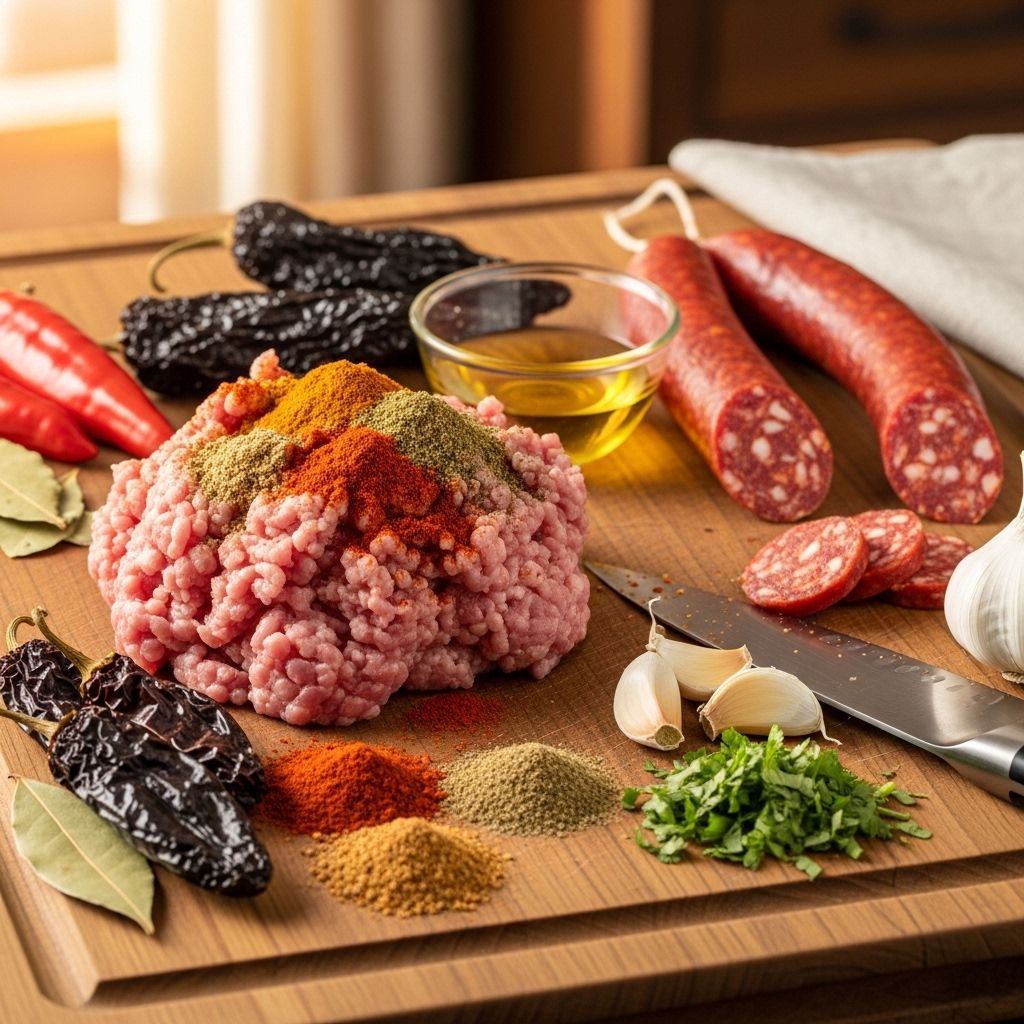Homemade Mexican Chorizo: From Scratch to Sizzle
A homemade approach that unlocks smoky, spicy chorizo made to your flavor preferences.

Mexican chorizo’s smoky, spicy kick is the soul of many classic dishes. Making chorizo at home delivers unbeatable flavor and lets you control seasoning and freshness. This guide details everything you need, from the essential ingredients and spice blends to expert tips, troubleshooting, and frequently asked questions. Whether you’re a seasoned cook or new to sausage-making, you’ll soon be turning out authentic Mexican chorizo worthy of your favorite dishes.
Introduction to Mexican Chorizo
Chorizo is a vibrant, highly seasoned sausage that’s a staple in Mexican kitchens. Unlike its Spanish counterpart, which is dry-cured and typically sliced, Mexican chorizo is a fresh sausage—uncooked, bold, and seasoned with vinegar, chili, garlic, and a vivid red spectrum of spices. Its versatility makes it a building block for tacos, eggs, stews, tamales, and more.
What Makes Mexican Chorizo Special?
- Freshness: It’s made from raw pork (or occasionally beef or chicken), not pre-cooked or cured.
- Bold Spices: Uses a wide array of ground dried chilies, aromatic spices, and tangy vinegar.
- Distinct Texture: The sausage is loose, crumbly, and perfect for blending into dishes.
Understanding the Key Ingredients
The allure of excellent chorizo comes from its punchy seasonings and the quality of the pork. A well-balanced blend yields a sausage that’s tangy, smoky, spicy, and absolutely irresistible.
Essential Ingredients
- Pork: Freshly ground pork with a good fat content (about 25 to 30%) is ideal.
- Dried Chilies: The backbone of flavor. Most recipes use a blend of mild and hot chilies such as guajillo, ancho, pasilla, and árbol.
- Spices and Aromatics: Commonly include garlic, cumin, coriander, Mexican oregano, cinnamon, and sometimes clove.
- Vinegar: White or apple cider vinegar brightens the mixture and gives it an unmistakable tang.
- Salt: Essential for flavor and to draw out the full complexities of the spices.
Ingredient Selection Tips
- Use fresh chili powder or grind your own from dried whole chilies for maximum flavor.
- If you want a spicier chorizo, increase the amount of árbol chilies or add a pinch of cayenne.
- For a leaner sausage, trim some fat, but don’t go below 20% fat for best juiciness.
Equipment Overview
You don’t need specialized tools to make great chorizo, but a few basic kitchen items will make the process smoother.
- Meat Grinder or Food Processor: For the freshest flavor, grind your own pork—or ask your butcher for coarse-ground pork shoulder.
- Blender or Spice Grinder: To make chili powder from whole dried chilies.
- Bowl and Gloves: Use a large bowl for mixing, and food-safe gloves to protect your hands from chili burn.
- Plastic Wrap or Airtight Containers: To let the flavors meld before cooking or freezing.
Step-by-Step Guide: How to Make Mexican Chorizo
1. Prepare the Chilies
- Remove stems and seeds from dried chilies. Toast briefly in a dry skillet until fragrant, then soak in hot water until soft.
- Drain chilies, reserving soaking water, and blend with a little soaking liquid to create a thick, aromatic paste.
2. Toast and Grind Spices
- Toast whole spices (cumin, coriander, clove) in a dry pan for robust flavor. Grind to a powder for even distribution.
3. Gather the Sausage Base
- In a mixing bowl, combine ground pork with chili paste, spices, minced garlic, vinegar, Mexican oregano, cinnamon, and salt.
- Mix thoroughly until the color is even and the mixture feels sticky.
4. Rest for Maximum Flavor
- Cover and refrigerate the mixture for at least a few hours, preferably overnight. This rest allows flavors to meld and develop.
5. Cook and Enjoy
- Brown in a skillet over medium heat, breaking up with a spoon. Mexican chorizo is typically cooked loose and crumbled for fillings, not stuffed in casings.
- Drain excess fat, if desired, and use in tacos, breakfast dishes, soups, or over beans.
Customization and Variations
The hallmark of homemade chorizo is adaptability. Adjust ingredients and method to suit your tastes and dietary needs.
Protein Choices
- Pork: Classic and most flavorful.
- Beef or Chicken: For lighter alternatives, but be aware that texture and flavor will shift.
- Vegetarian/Vegan: Try using crumbled tofu or tempeh, adjusting spices and liquid ingredients to saturate the base well.
Spice Adjustments
- Modify the types and amounts of chilies to control heat and smokiness.
- Omit clove or cinnamon for a subtler flavor profile.
- Increase or decrease vinegar to change tanginess.
Make it Your Own
Experiment with homemade smoked chilies, extra garlic, or even a dash of mezcal for a unique twist.
Serving Suggestions
- Tacos: Crumbled chorizo is perfect in warm tortillas with cilantro, onion, and salsa.
- Huevos con Chorizo: Scramble into eggs for a classic Mexican breakfast.
- Sopes and Quesadillas: Use as a filling with cheese, beans, and lettuce.
- Sopa de Chorizo: Simmer in soups or stews for deep, smoky flavor.
Storage and Make-Ahead Tips
- Refrigeration: Uncooked chorizo keeps in the refrigerator up to 5 days, tightly sealed.
- Freezing: Portion and freeze for up to 3 months. Thaw overnight before cooking.
- Meal Prep: Make a big batch and cook as needed to keep meal options open all week.
Troubleshooting and Common Mistakes
- Dry Chorizo: Meat not fatty enough. Don’t skimp on the pork fat.
- Bland Flavor: Use fresh spices, toast and grind whole when possible. Don’t forget the resting step for flavor development.
- Too Salty or Acidic: Start with less salt or vinegar; you can always add more after a taste test.
- Crumbling or Breaking Apart: Mix thoroughly to develop a sticky, cohesive mixture.
Nutrition Information
| Serving Size | 2 ounces (about 56g) |
|---|---|
| Calories | 160 |
| Protein | 7g |
| Fat | 14g |
| Carbohydrates | 2g |
| Sodium | 350mg |
Note: Values are approximate; adjust per the specific ingredients and ratio you use.
Frequently Asked Questions (FAQs)
Q: Can I use store-bought chili powder instead of whole chilies?
A: Yes, but grinding whole dried chilies yields richer, more complex flavors. Use fresh, high-quality chili powder for a shortcut.
Q: Is it necessary to use pork fat?
A: Fat is key to juicy, tender chorizo. Using lean pork will make the sausage dense and crumbly rather than moist.
Q: Can I freeze uncooked chorizo?
A: Absolutely! Portion it into meal-size amounts, wrap tightly, and freeze for up to three months. Thaw in the fridge before use.
Q: What’s the best way to cook chorizo?
A: Brown over medium heat in a dry skillet, breaking it up as it cooks. Drain excess fat if desired.
Q: Is Mexican chorizo gluten-free?
A: Yes, when made from scratch with pure spices and meat, it contains no gluten by default.
Conclusion
Homemade Mexican chorizo rewards the cook with bold flavors, irresistible aromas, and unmatched versatility in the kitchen. By blending the right seasonings, using quality meat, and following these easy steps, you’re set to enjoy authentic chorizo—whether as the star in a simple taco or boosting the savor of your go-to family dishes. Buen provecho!
References
Read full bio of Srija Burman












